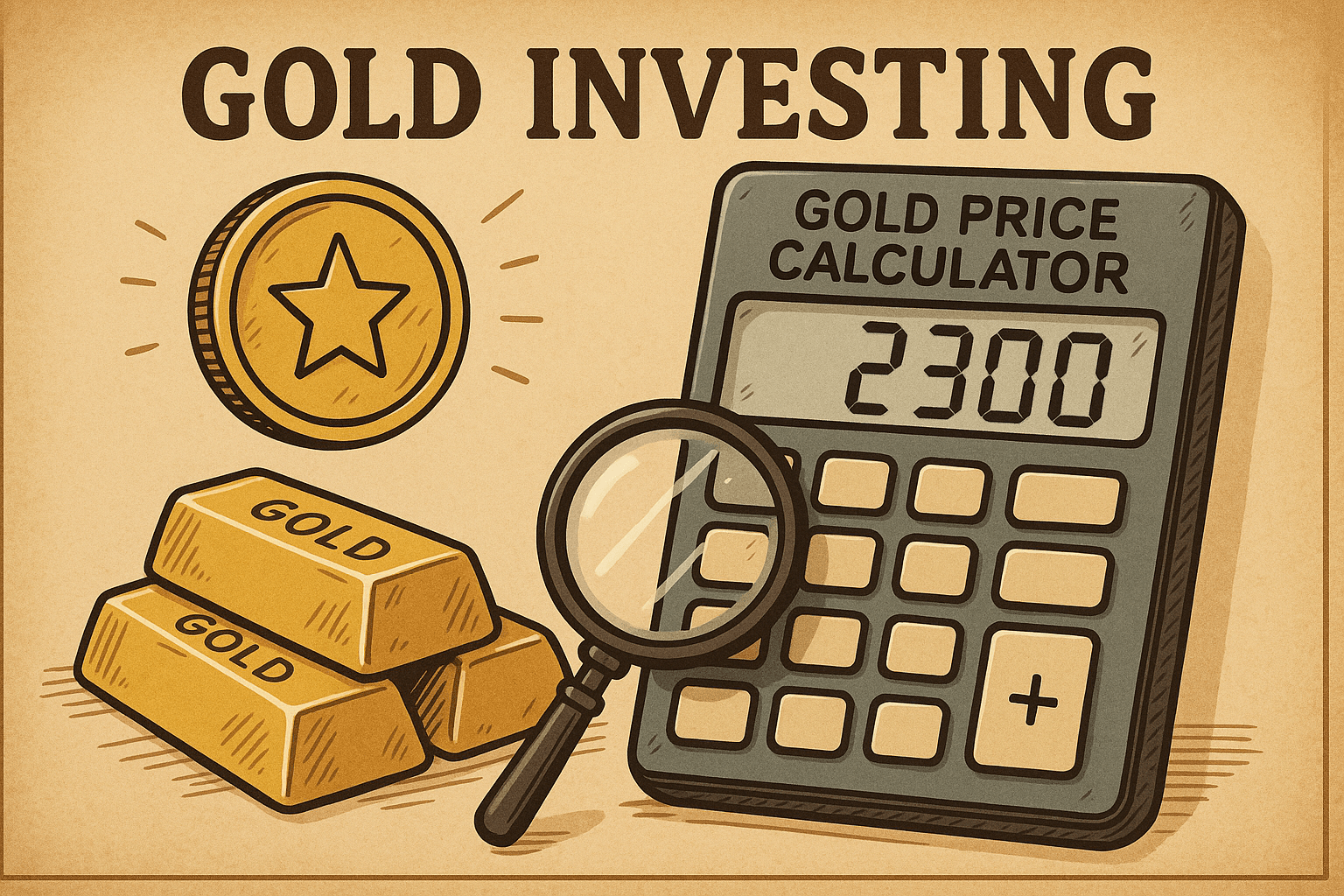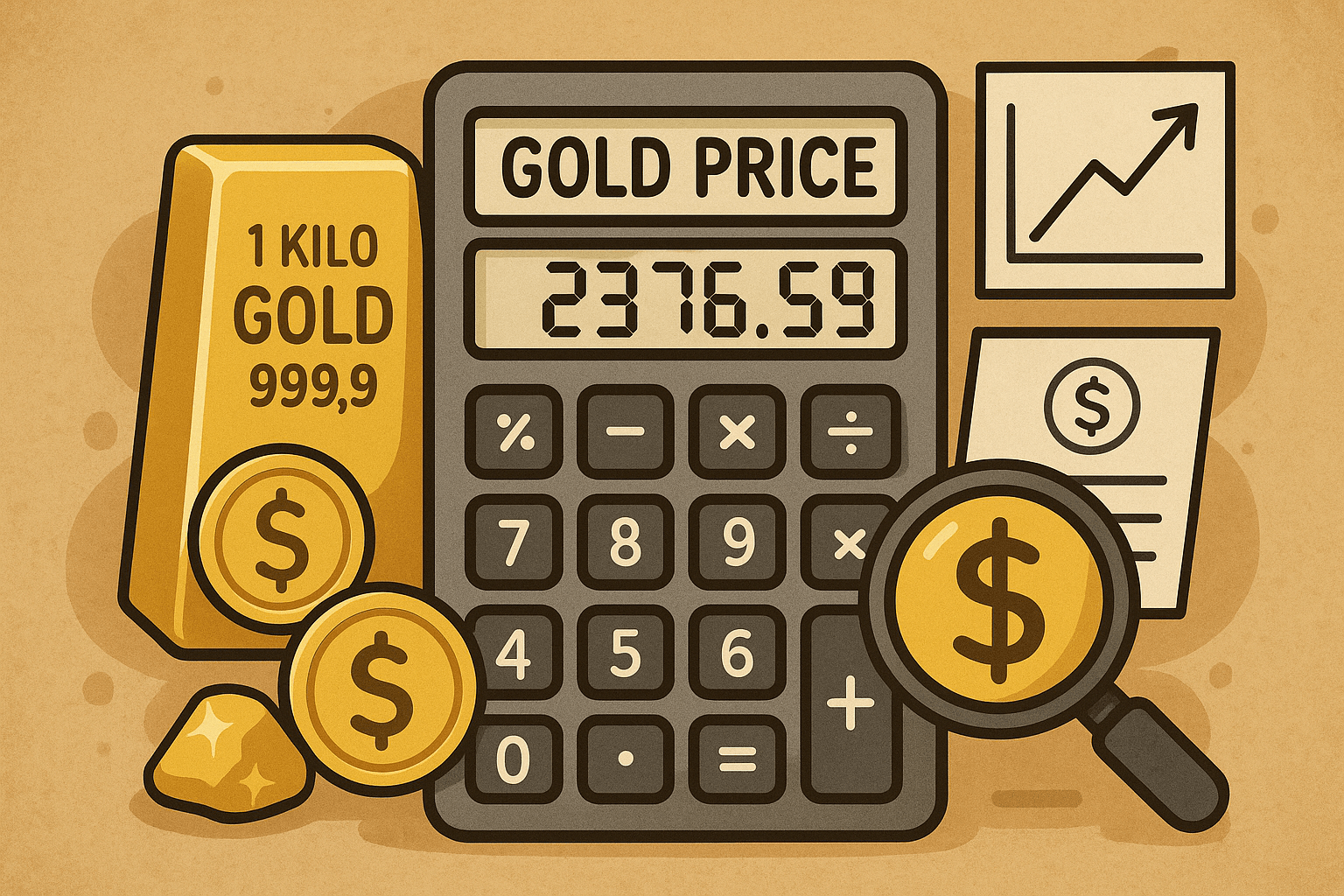Navigating the world of gold investing can feel like deciphering an (best gold price calculator) ancient code. With prices fluctuating by the second and premiums varying wildly, how can you be sure you’re getting a fair deal? The answer lies in using the right tool. Finding the best gold price calculator is not just a convenience; it’s a necessity for anyone serious about buying or selling precious metals. This essential tool demystifies the complex pricing structure, empowering you to make informed financial decisions, whether you’re purchasing a single gram of jewelry or a kilogram bar for your portfolio.
This comprehensive guide will break down everything you need to know. We’ll explore the critical differences between retail and wholesale calculations, review the top calculators available today, and explain the hidden factors that every savvy investor must consider.
https://images.unsplash.com/photo-1590283603385-17ffb3a7f29f?ixlib=rb-4.0.3&ixid=M3wxMjA3fDB8MHxwaG90by1wYWdlfHx8fGVufDB8fHx8fA%253D%253D&auto=format&fit=crop&w=1470&q=80
Alt Text: Using the best gold price calculator on a tablet to evaluate investment options.
Why You Absolutely Need a Gold Calculator
Gold isn’t priced like a stock or a currency. Its value is a combination of several layers:
-
Spot Price: The baseline price for one troy ounce of pure (.999 fine) gold, traded on global commodities exchanges like COMEX. This is the starting point for all calculations.
-
Premium: This is the additional cost over the spot price. It covers the minting costs, design, dealer markup, and a small profit margin. Premiums are higher for retail products like coins and small bars.
-
Purity (Karat): Especially crucial for jewelry, the karat (e.g., 24k, 22k, 18k) denotes the percentage of pure gold in the alloy. A calculator must adjust for purity.
-
Weight: Gold is measured in troy ounces (ozt), grams (g), and sometimes kilograms (kg) or Tolas. Accurate conversion is vital.
A robust gold price calculator seamlessly integrates all these variables, giving you a true apples-to-apples comparison and protecting you from overpaying.
Retail vs. Wholesale: Two Different Worlds
The “best” tool depends entirely on your needs. The requirements for a retail buyer are fundamentally different from those of a wholesale trader.
For the Retail Investor/Buyer
The retail buyer is typically purchasing smaller quantities—coins, bars, and jewelry—from dealers. Their primary goal is to find the lowest total premium and understand the buy-back price.
Key Features a Retail Calculator Must Have:
-
Live Spot Price Feed: Prices change constantly. The calculator must update in real-time.
-
Product-Specific Premiums: Ability to select from a list of common products (e.g., American Eagle, Canadian Maple Leaf, PAMP Bar) that have their own typical premiums.
-
Purity Adjustment: A simple karat selector (24k, 22k, 18k, 14k, etc.) for jewelry.
-
Weight Conversion: Easy input in grams, ounces, or kilograms.
-
Total Final Price Display: A clear breakdown:
(Spot Price + Premium) * Weight = Your Cost. -
Buy/Sell Spread Calculator: Shows what a dealer would pay you if you sold to them (which is always below the spot price).
For the Wholesale Trader/Business
Wholesale traders deal in large volumes (e.g., 1 kg bars, 100 oz bars) and often trade with other dealers or institutions. Their margins are thinner, and speed and precision are paramount.
Key Features a Wholesale Calculator Must Have:
-
Bulk Calculation: Ability to calculate the value of large lots (e.g., ten 1-kg bars).
-
Low Premium Inputs: Wholesale premiums are minuscule. The calculator should allow for custom premium input down to a fraction of a percent.
-
Advanced Weight Units: Support for troy ounces, kilograms, and sometimes Tolas or Taels for international trade.
-
Portfolio Valuation: Functionality to input a diverse inventory of different products and purities and get a total portfolio value.
-
API Integration (For Advanced Users): Direct integration with live market data feeds for proprietary trading platforms.

Top Contenders for the Best Gold Price Calculator
Based on accuracy, features, and user experience, here are some of the top calculators available.
1. JM Bullion Gold Calculator
-
Best For: Retail Buyers & Beginners
-
Why It’s Great: JM Bullion offers an incredibly user-friendly and transparent calculator. You select your product type (e.g., Gold American Eagle, Gold Bar), enter the quantity, and it instantly shows the total price with their premium included. It also clearly displays the live spot price and the premium per unit, fostering trust.
-
Link: JM Bullion Calculator
2. Kitco Gold Calculator
-
Best For: Enthusiasts & Market Watchers
-
Why It’s Great: A industry staple for decades, Kitco provides a powerful and detailed calculator. It allows you to select any currency, adjust for any purity (karat), and choose any weight unit. It’s less product-specific and more metric-focused, making it excellent for calculating the value of scrap gold or unusual items.
-
Link: Kitco Gold Calculator
3. GoldPrice.org Calculator
-
Best For: Quick, No-Frills Calculations
-
Why It’s Great: This site is known for its clean, simple interface and lightning-fast load times. Its calculator is straightforward: enter the amount and weight, select the karat, and get an instant value based on the live spot price. It’s perfect for a quick check without the distraction of dealer premiums.
-
Link: GoldPrice.org Calculator
4. APMEX Gold Calculator
-
Best For: Comparing Retail Premiums
-
Why It’s Great: Similar to JM Bullion, APMEX, another giant in the retail space, has a reliable calculator that shows their specific pricing. Savvy investors often use both APMEX and JM Bullion calculators to compare premiums on the same product before buying.
-
Link: APMEX Calculator
Case Study: How a Calculator Saves You Money
Scenario: Anna wants to buy a 1-oz gold bar. Dealer A offers it for $2,100. Dealer B offers it for $2,050. Which is better?
A novice might jump at Dealer B’s offer. An informed investor uses a calculator:
-
They check the live spot price, which is $2,000 per oz.
-
They calculate the premium:
-
Dealer A: ($2,100 – $2,000) / $2,000 = 5% premium
-
Dealer B: ($2,050 – $2,000) / $2,000 = 2.5% premium
-
Dealer B is indeed the better deal. But what if the spot price moved and Dealer A’s website hadn’t updated yet? The calculator, pulling live data, reveals the truth and prevents a costly mistake.

Beyond the Calculator: Pro Tips for Accurate Valuation
-
Understand Bid vs. Ask: The “ask” price is what you pay to buy. The “bid” price is what you get when you sell. A good calculator shows both.
-
Check the Data Source: Ensure the calculator pulls its spot price from a reputable source like the London Bullion Market Association (LBMA) or COMEX.
-
Factor in All Costs: For online dealers, remember to add shipping and insurance to the final calculation. For local stores, consider sales tax, which may apply to some products but not others (e.g., coins vs. jewelry).
Conclusion: Empowering Your Gold Investments
In the gleaming and often opaque gold market, knowledge is truly power. The best gold price calculator acts as your personal financial translator, converting complex market data into a clear, actionable price. For retail buyers, it’s a shield against overpaying; for wholesale traders, it’s a precision instrument for profit.
By choosing a calculator that aligns with your specific needs—whether it’s the user-friendly retail interface of JM Bullion or the metric-heavy power of Kitco—you take control. You stop guessing and start investing with confidence, ensuring that every transaction you make is built on a foundation of clarity and accurate information.
Frequently Asked Questions (FAQs)
Q1: How often is the spot price updated in these calculators?
Most reputable calculators update their spot price every 30 to 60 seconds during market hours to reflect the live trading price on global exchanges.
Q2: Is the price from the calculator the final price I’ll pay?
Almost, but not quite. The calculated price will be the dealer’s price for the metal. You must still add any additional costs like shipping, handling, payment processing fees (for credit cards), or applicable taxes to get your final out-the-door cost.
Q3: Which weight unit should I use: grams or troy ounces?
For small items like jewelry, grams are more practical. For coins and bars, troy ounces are the global standard. One troy ounce equals approximately 31.103 grams. A good calculator will handle the conversion for you.
Q4: Why is the selling price (bid) always lower than the buying price (ask)?
This difference, known as the “spread,” is how dealers and markets make a profit. It’s a fundamental aspect of trading any asset, not just gold.
Disclaimer: This article is for educational and informational purposes only and does not constitute financial, investment, or trading advice. You should conduct your own research and consult with a qualified financial advisor before making any investment decisions. Gold prices are highly volatile and investing carries risk. While we strive to provide accurate information, we make no guarantees regarding the accuracy of prices or calculations from external tools linked in this article. If you have any concerns about the content of this post, please visit our DMCA page for guidance on content removal.
